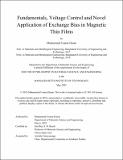Fundamentals, Voltage Control and Novel Application of Exchange Bias in Magnetic Thin Films
Author(s)
Hasan, Muhammad Usama
DownloadThesis PDF (5.772Mb)
Advisor
Beach, Geoffrey S. D.
Terms of use
Metadata
Show full item recordAbstract
The past half-century has seen remarkable advances in microelectronics, but as transistors approach their physical limits, there is a growing need for beyond-CMOS technologies. Spintronics, which aims to utilize the electron's spin in magnetic thin films for data storage and manipulation, is a promising alternative. Among the rich physical interactions that appear in magnetic thin films, the exchange-bias (EB) effect is essential for many spintronic devices. EB is an effect that arises at ferromagnet/antiferromagnet interfaces, which imposes an internal field on the ferromagnet, enhancing the range of functionalities that can be derived from devices. This thesis explores EB in Co/Co₁₋ₓNiₓO systems at multiple levels, from fundamental understanding to its manipulation and applications. First, we introduce a new model to predict EB in polycrystalline antiferromagnetic thin films and validate it with experimental data. Second, we tackle another fundamental aspect – disentangling the effects of EB on nucleation and propagation of magnetization reversal. We discover that nucleation and propagation EB can be unequal and demonstrate how that can lead to unexpected behavior of the system, including having asymmetric hysteresis loops. Building on these insights, we demonstrate voltage-controlled ionic gating to manipulate EB, achieving cyclic toggling of the EB sign in a ferrimagnetic system, where the magnetization direction is fully determined by the gating state. Furthermore, by targeting the antiferromagnet directly, we discover EB enhancement up to 100%, which can be explained with the help of the model developed earlier. We demonstrate sub-millisecond and analog operation in this system. Finally, a new approach to improving bit-stability whilst preserving performance in magnetic racetrack memory is proposed which involves incorporating an EB layer with the right properties into the track. The benefits obtained from this strategy can help push this next-gen memory device closer to commercialization. We believe the findings in this thesis substantially extend the state-of-the-art in terms of basic understanding of EB, ways of EB manipulation and unexplored use-cases of EB, paving the way for new functionalities in spintronic devices applicable for non-conventional computing paradigms or next-gen memory devices.
Date issued
2025-05Department
Massachusetts Institute of Technology. Department of Materials Science and EngineeringPublisher
Massachusetts Institute of Technology